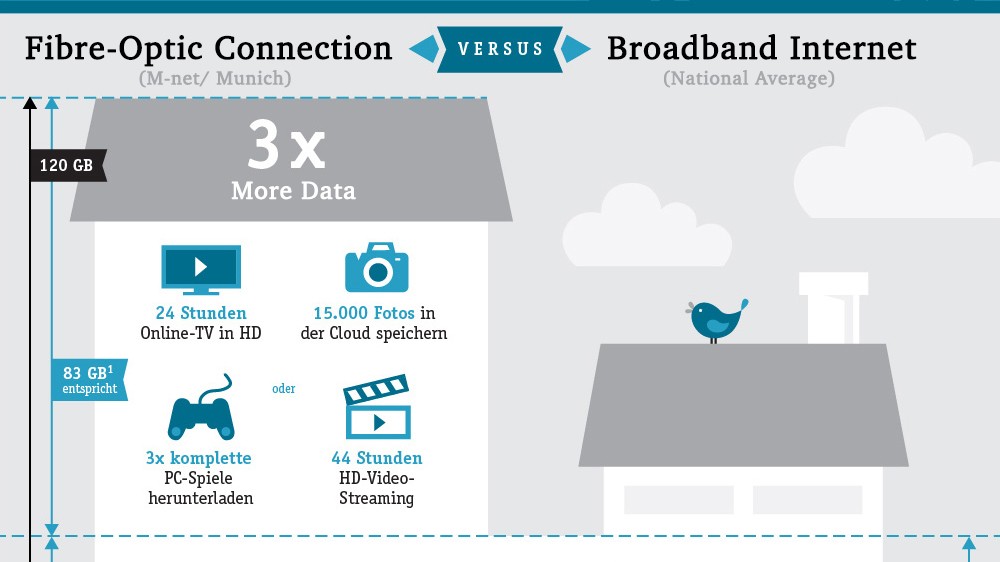One Million FTTH Connections – Data Volumes Pose the Biggest Challenge
Stefan Kreibig from inexio explains how the inexio network has evolved since inception, and writes about their ambitious goals for fiber-to-the-house connections.

© kynny | istockphoto.com
German telecommunications provider inexio has set the ambitious target of increasing its private Internet customers from 100,000 to 1,000,000 by 2030. This increase poses major challenges for the company’s core and transport networks, as streaming services from the likes of Netflix, YouTube, and Amazon are finding their way into ever more German households. This means that rapidly increasing volumes of data have to be transported through cyberspace. In order to guarantee this transportation, inexio has built a network comprising 36 main locations. These are usually situated in large data centers and equipped with emergency power systems which can take over the electricity supply at the sites for several hours in the event of a power failure. The individual local networks are connected to the Internet via 10 Gigabit Ethernet from these core locations.
A look back: how it all began, 10 years ago
Ten years ago, speeds in the region of 100 Gbit/s in inexio’s core network would have been unthinkable. Fiber optic cables were often wired up to direct 10 Gbit/s Ethernet connections, and the core network still included 155 Mbit/s (0.155 Gbit/s) connections.
After inexio connected the first residential customers to the network in 2009 and a significant demand for bandwidth arose as a result, direct Ethernet connections using DWDM technology (dense wavelength division multiplexing) were gradually built on the fiber optic lines and new core network locations were established. This enabled inexio to increase the speed on a fiber optic cable from 10 Gbit/s to a maximum bandwidth of 320 Gbit/s in 2009.
DWDM technology makes it possible to convert a signal into a precisely defined color of light (channel) and transmit it in a bundle with other light colours via two optical fibers. These bundled light colors can be separated back into their individual components at the other end of the optical fiber. This bundling and unbundling takes place via filter systems which bring the individual light colors together on a fiber optic line and divide them again at the opposite end of the line.
The individual light colors are defined by ITU G.694.1 and are subject to very precise standardization. This means that several different 10 Gbit/s services can be transmitted simultaneously via just two optical fibers. By using optical amplifier systems together with DWDM technology, a signal can be transmitted up to 800 kilometers without having to be opto-electronically converted.
The inexio network currently offers 32 different usable channels on one pair of optical fibers. These can be connected with a maximum bandwidth of 200 Gbit/s per light color. Without this supporting DWDM structure, inexio would have to switch 32 pairs of optical fibers between two core network locations to achieve a speed of 320 Gbit/s, which is clearly a less economical option.
Partners since the very beginning
Inexio’s DWDM technology has been provided by ADVA right from the start. Over the last 10 years, the vendor has proven to be a reliable and competent partner who has shaped the core network with its expertise and ongoing development, and will continue to do so in the future.
With the decision to focus primarily on optical fiber home connections in the future and to raise the number of customers to one million, the company was faced with the question of how to align the core network with the expected volumes of data. An important factor in the decision was that inexio needed to be able to continue increasing speeds in its core network as simply and quickly as possible to match the increasing number of customers.
A peek inside inexio’s DWDM transport network
As of May 2019, inexio has illuminated around 3,200 kilometers of optical fiber in southern Germany using DWDM technology and FSP 3000. Through FSP 3000, the 36 core network locations are provided with a bandwidth of 200 Gbit/s per light color. This means that a maximum bandwidth of 6,400 Gbit/s (6.4 Tbit) can currently be transmitted over a fiber optic line in the core network.
The remaining 8,000 kilometers of fiber optic network bring the required bandwidths from the core network locations to the local networks supplied by inexio, connecting customers to the Internet.
By using the selected hardware and software, it will be possible to increase the speed from 200 Gbit/s to 600 Gbit/s per light color in future, which will provide a maximum available speed of 19.2 Tbit/s in the company’s core network.
To put it in a nutshell: inexio has developed a powerful, future-oriented core network which can easily transport and manage the data volumes that will be required in the future.
Stefan Kreibig heads the Fiber Network and Transport department at inexio. He holds a degree in Business Information Systems, and together with his team, he manages the core and DWDM transport network along with inexio’s entire 11,000-kilometre fiber optic network.
Please note: The opinions expressed in Industry Insights published by dotmagazine are the author’s own and do not reflect the view of the publisher, eco – Association of the Internet Industry.





